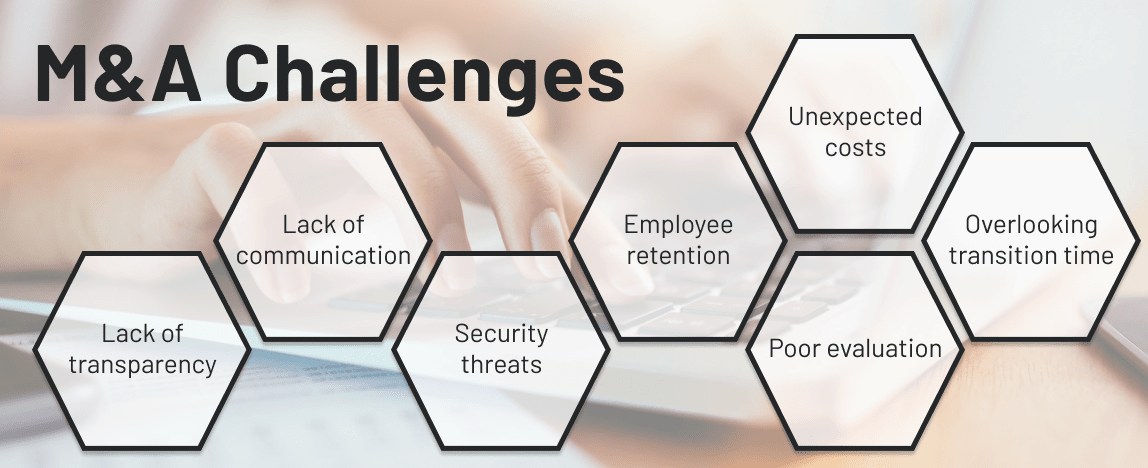

No doubt, each M&A transaction encounters unforeseen hurdles along the way. Transparency, real-time updates, and a clear presentation of conditions are critical components for M&A deal success.
Understanding the possible risks of mergers and acquisitions beforehand can increase partner confidence and deal success. Here follows a list of the seven biggest challenges of mergers and acquisitions and how to overcome them.
1. Lack of transparent, well documented, and structured M&A process
To establish trust among partners, auditors, and regulators, it is crucial to present a clear, start-to-finish process for your M&A transaction. Laying out all phases, stakeholders, requirements for partners, as well as interconnections among processes, will not only make you feel in control but will also make your team and partners feel more confident. Such a holistic framework helps track progress, maintain control of a particularly hectic and stressful time for your business.
- M&A deals led by transparency increase partner trust and are more likely to succeed.
Transparency can be achieved even with minimal investments. A virtual data room can be a useful tool for laying out a structured M&A process. If your company already has a virtual data room, you can create a separate document tree for M&A within the existing data repository. Introducing a virtual data room as you begin the M&A process might ask for additional capacity, however, it will pay off in the long run as data rooms can increase the efficiency of due diligence.
Top 3 VDRs to overcome M&A challenges
2. Lack of communication
Communication (or miscommunication) has the power to make or break a deal within seconds. Starting from early negotiation meetings to team integration and merging company cultures, frequent dialogue between the two merging companies’ management and employees is vital to ensure alignment and shared vision.
Communication with the media should not be overlooked as well. Prepare uniform facts for the media and your employees and keep all communication consistent to avoid unnecessary setbacks. Communicate with your employees early and regularly, so they know what to expect. You can use a virtual data room as a platform to do that. Create a separate conversation thread or a Q&A section to answer all employee questions in one place.
3. Security threats
Data is one of the most powerful resources of the digital age. When a company acquires another company, heavy loads of sensitive information are shared with multiple parties. Information like brand secrets, intellectual property, financial statements, employee personnel files, etc., are a big target for cybercrime. Choosing secure data room software can save many headaches and expenses associated with digital data breaches.
To reduce security risks, and thus, possible issues in mergers and acquisitions, consider utilizing a reliable virtual data room. The most secure VDR solution will have:
- top-level security standard compliance such as ISO 27001, SOC, and GDPR
- strong encryption protocols
- an option to set granular user permissions
- multi-factor authentication
- audit trails on user activity
4. Employee retention challenges
One of the biggest challenges involved with personal selling is employee retention. Understandably, employees might feel extra stress due to uncertainty — job security, organization’s future, location changes, pay, daily routine, and tasks. Employees and their knowledge are one of the most critical resources to protect during a merger. It is highly recommended to minimize turnover as much as possible to ensure business continuity.
- Employees, their knowledge, skills and customer relationships are one of the most critical resources to protect during a merger.
To document institutional knowledge, transfer business processes and policies, you need to set up a system for identifying critical knowledge held by existing employees. A virtual data room can serve as a good repository for documenting, storing, and updating the most essential information. VDR can also be the main tool for knowledge transfer when onboarding new employees.
5. Poor evaluation and overestimation
Many M&A deals have failed to bring value to the buyer due to poor evaluation, which leads to overpaying. You can minimize the risk by taking proactive measures and setting up an analytical, scrutinized approach to due diligence.
Due diligence requires the seller to provide all necessary documentation for the buyer to verify a fair market value of the acquisition. Thoroughly analyzing available data will lead to more data-driven assumptions. Based on the findings, you can adapt your strategy. Another important aspect is to share relevant findings with your team of experts to ensure everyone is aware of the conditions and is adjusting their expectations accordingly.
To minimize the risk of overestimation, consider using a virtual data room for due diligence. A virtual data room will help organize files, set up and keep track of the due diligence workflow, share information securely with your team, and provide a better deal overview. With a virtual data room, you can generate reports quickly, review files simultaneously, communicate with your team in real-time, and have all the facts for negotiating with the seller.
6. Overlooking transition time
One of the problems of merger and acquisition after the deal is not devoting enough time and resources for transition. It is important to understand the learning curve for successful post-merger integration and motivate employees to collaborate with the new, consolidated team.
To tackle this challenge, have a post-merger strategy in place and assign resources to manage the transition. Most likely, there will be two employees from each company doing the same job — which may cause friction. Take it slowly, set up communication channels, create an atmosphere of collaboration rather than competition. Set up internal policies and organize cross-cultural training to achieve the best result — merge the best talent from both companies to increase productivity.
A virtual data room can serve as a platform for communication, knowledge exchange, and presenting a clear picture of the transition process. When everyone has access to the same information and facts, employees can feel equal, included, and well-informed.
7. Unexpected costs
There are many hidden costs associated with mergers and acquisitions. With inaccurate financial projections, the deal can easily result in decreased shareholder value. In addition to deal-related costs, consider also:
- Employee retention expenses: pay raise, promotions, bonuses
- Employee training expenses
- Advisor and legal fees (unanticipated)
- Additional HR expenses
- Rebranding expenses
- Technology, equipment, software, and office space rental expenses
A cost-benefit analysis should be a part of the due diligence process. Being aware of these costs will help you prepare if you reach the limit. Virtual data room software can be a good investment for tracking expenses, following deal progress, and comparing the true figures with estimates. Your team can update strategies, financial projects, and management reports effortlessly using a centralized virtual space. Outsourced advisors can review and respond to requests quickly, from any location at any time, as long as you grant them access to your data room.
References
- Bahreini, Dariush, Roerich Bansal, Gerd Finck, and Marjan Firouzgar. 2021. “Done Deal? Why Many Large Transactions Fail To Cross The Finish Line”. Mckinsey & Company. https://www.mckinsey.com/business-functions/strategy-and-corporate-finance/our-insights/done-deal-why-many-large-transactions-fail-to-cross-the-finish-line
- Combs, Valerie. 2021. “Council Post: M&A: A Smart Communications Strategy Can Make Or Break A Deal”. Forbes. https://www.forbes.com/sites/forbescommunicationscouncil/2019/09/24/ma-a-smart-communications-strategy-can-make-or-break-a-deal
- “Employee Engagement Challenges With Mergers & Acquisitions | Impraise”. 2021. Impraise. https://www.impraise.com/blog/employee-engagement-challenges-with-mergers-acquisitions
- “Managing M&A Communication — Financier Worldwide”. 2021. Financier Worldwide. https://www.financierworldwide.com/managing-ma-communication
- “Strategies To Avoid The Overpayment Trap – Moneysoft® – Resources For Sound Business Decisions™”. 2021. Moneysoft® – Resources For Sound Business Decisions™. https://moneysoft.com/strategies-to-avoid-the-overpayment-trap
- Young, Kristie M, DBA, Stammerjohan, William W. Pd.DBennett, Rebecca J., Ph.D., Drake, Andrea R., Ph.D. The Hidden Cost of Mergers and Acquisitions
- “Top Ten Greatest Remaining Challenges In M&A | M&A Partners”. 2021. Mapartners.Net. https://www.mapartners.net/insights/top-ten-greatest-remaining-challenges-ma
Recommended for you

